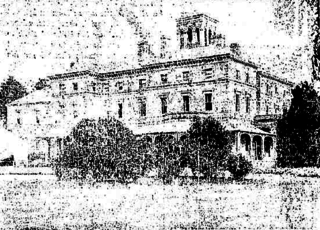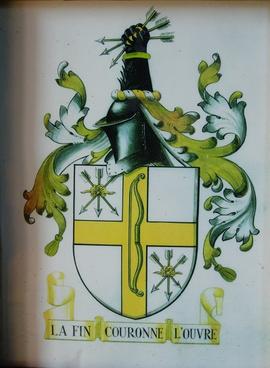
Tasmania is an island state of Australia. It is located 240 kilometres (150 miles) to the south of the Australian mainland, separated from it by the Bass Strait, with the archipelago containing the southernmost point of the country. The state encompasses the main island of Tasmania, the 26th-largest island in the world, and the surrounding 1000 islands. It is Australia's least populous state, with 569,825 residents as of December 2021. The state capital and largest city is Hobart, with around 40 percent of the population living in the Greater Hobart area. This makes it Australia's most decentralised state.

Longford is a town in the northern midlands of Tasmania, Australia. It lies 145 m above sea level at the convergence of the Macquarie River and the South Esk River, 21 km south of Launceston and a 15-minute drive from the airport. It is just south of the Illawarra Road, a road connecting the Bass and Midland Highways. It has a population of 3,863 and is part of the Northern Midlands Council area. The region is predominantly agricultural, noted for wool, dairy produce and stock breeding.

Bothwell, Tasmania is a small town with a population at the 2016 census of 485. Situated in central Tasmania on the River Clyde in a broad valley, it is notable for hunting and being a lake district. It is part of the municipality of Central Highlands Council and will celebrate the bicentenary of its founding in 2022. Nearby locations include Hollow Tree, Hamilton, Ouse and Kempton.
Ross Bridge is an historic bridge in the town of Ross in central Tasmania, Australia, completed in July 1836. It crosses the Macquarie River.

The Tasmanian Museum and Art Gallery (TMAG) is a museum located in Hobart, Tasmania. The museum was established in 1846, by the Royal Society of Tasmania, the oldest Royal Society outside England. The TMAG receives 400,000 visitors annually.

Ross is a village in the Midlands of the state of Tasmania in Australia. On the Macquarie River, Ross is located 78 km south of Launceston and 117 km north of Hobart. The town is listed on the Register of the National Estate and is noted for its historic bridge, original sandstone buildings and convict history.

The Albert Hall is a convention centre in Launceston, Tasmania in the style of high Victorian architecture, first opened as the main structure for the Tasmanian Industrial exhibition which ran from 25 November 1891 to 22 March 1892. It is located on the corner of Tamar Street and Cimitiere Street. It was first listed on the Register of the National Estate on 21 March 1978.

The Red Bridge in Tasmania crosses the Elizabeth River at Campbell Town. Built in 1838 using penal labour, it is the oldest surviving brick arch bridge in Australia, as well as the oldest bridge anywhere on the National Highway. The bridge contains three arch spans of 7.6 m (25 ft) each and holds two lanes of traffic as well as pedestrian walkways. It lies on the Midland Highway, roughly halfway between Hobart and Launceston, carrying over two million vehicles per year.

Brickendon Estate is a farm estate located in Longford, Tasmania. It is one of the two main ancestral homes of the Archer family, prominent local pioneers and politicians.

Australian Convict Sites is a World Heritage property consisting of 11 remnant penal sites originally built within the British Empire during the 18th and 19th centuries on fertile Australian coastal strips at Sydney, Tasmania, Norfolk Island, and Fremantle; now representing "...the best surviving examples of large-scale convict transportation and the colonial expansion of European powers through the presence and labour of convicts".

Entally House is a heritage-listed site in Hadspen, Tasmania. It was the family home of Thomas Reibey who was the Premier of Tasmania from 1876 to 1877. The Entally Estate was established in 1819 by Thomas Haydock Reibey (senior). Reiby worked in the East India company, and named the house after the suburb of Entally in Calcutta, India.

Mona Vale is a large heritage listed 1860s country house in Ross, Tasmania. Completed in 1867, it is well known locally as the "Calendar House", for its reportedly 365 windows, 52 rooms, 12 chimneys and seven entrances. The property is on the Tasmanian Heritage Register and the Register of the National Estate.

Franklin House in Franklin Village, near Launceston, Tasmania, is a historic house that is preserved by Tasmania's National Trust and is open to the public. Built in 1838 for Britton Jones, it later became a school for boys.
William Archer (1820–1874) was an Australian architect, naturalist, grazier, politician and member of the prominent Archer family. He was the second son of Thomas Archer, a prominent pastoralist and politician himself. A keen interest in architecture led to him going to London to study architecture when he finished school, where he studied under William Rogers and Robert Stephenson. During his life he built many colonial buildings across Tasmania, served as a member of both the Tasmanian House of Assembly and Tasmanian Legislative Council and made significant contributions to botany, with several native Tasmanian plants named after him. Despite this he died penniless at his brothers house Fairfield on 15 October 1874.

Henry Hunter (1832–1892) was a prominent architect and civil servant in Tasmania and Queensland, Australia. He is best known for his work on churches. During his life was also at various times a state magistrate of Tasmania, a member of the Tasmanian State Board of Education, the Hobart Board of Health, a Commissioner for the New Norfolk Insane Asylum and President of the Queensland Institute of Architects.

The Archer family are a notable family in Tasmania, Australia, prominent in society, business and politics of Tasmania for the last two centuries. They are best known today for their now world-heritage listed farm estates, Brickendon Estate and Woolmers Estate, but have contributed to many areas of Tasmania throughout their history. Other members of the family have been Mayors of Hertford in England and participated in the American Civil War.
Cheshunt House is an Italianate mansion in the Meander Valley, Tasmania, 10 kilometers from Deloraine. It was designed and originally owned by politician, botanist and architect William Archer, started in 1851-52. It was purchased incomplete by the Bowman Brothers from William Archer in 1873, who completed it to his design in 1885. It fell into disrepair during the period of the World Wars and the Great Depression, before a restoration project was undertaken by the family in the 1970s. It is still owned by the Bowman family.
Symmons Plains Estate is a historic farm and mansion in the locality of the same name, near Perth, Tasmania. A 856ha property, the estate dates back to 1820s, with the main Georgian house built in 1839. It is listed on the Tasmanian Heritage Register. In 1978, the homestead and its garden and outbuildings were registered on the now-defunct Register of the National Estate.
The Tasmanian Heritage Register is the statutory heritage register of the Australian state of Tasmania. It is defined as a list of areas currently identified as having historic cultural heritage importance to Tasmania as a whole. The Register is kept by the Tasmanian Heritage Council within the meaning of the Tasmanian Historic Cultural Heritage Act 1995. It encompasses in addition the Heritage Register of the Tasmanian branch of the National Trust of Australia, which was merged into the Tasmanian Heritage Register. The enforcement of the heritage's requirements is managed by Heritage Tasmania.
















